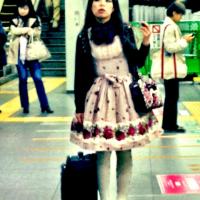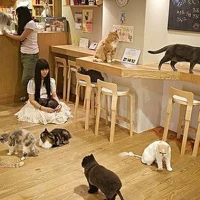(For an English translation, please scroll down)
Shodou; de geschiedenis
Japan had naar alle waarschijnlijkheid geen schrift voordat de Chinese karakters werden geïntroduceerd in het land. Het oudste artikel wat ooit is teruggevonden is de Kin’in (gouden postzegel) die aan de Japanse keizer werd gegeven door de keizer van China tijdens de late Han
periode.
kanji, on’yomi en kun’yomi
De adoptie van het Chinese schrift was helaas niet ideaal voor Japan. Doordat China en Japan destijds veel handel dreven, werden veel nieuwe woorden vanuit China letterlijk overgenomen. Deze karakters pasten netjes bij de desbetreffende woorden. Een ander probleem was dat
Japanners vaak niet goed de klanken uit de Chinese taal konden nadoen, en daardoor zijn de Japanse klanken vaak net iets anders dan de Chinese klanken. De introductie van het Chinese schrift is met golven gegaan en vanuit verschillende regio’s. Hoewel de voertaal in China momenteel Mandarijn is, was dat in het verleden anders en werd in elk district een ander dialect of zelfs een compleet andere taal gesproken. De Chinese karakters die in China werden gebruikt waren wel universeel, maar de uitspraak dus niet. Hierdoor kwam het dat er meerdere soorten uitspraken werden verbonden met 1 karakter. (On’yomi) Later werden Chinese karakters geselecteerd op basis van betekenis (Kun’yomi). Een Japanse verta-ling van het Chinese karakter werd gezocht en die werd vanaf dan verbonden met het karakter. Toen later hiragana werd geintroduceerd werd hiraga gebruikt als aanvulling in combinatie met het Chinese karakter aangezien het Japanse woord vaak niet geheel aansloot op het Chinese karakter waardoor aanvulling nodig was.
Shotoku-taishi (de prins van keizer Yomei) zond een koerier naar China in 607, tijdens de Sui Dynastie. De koerier bracht de kennis voor het produceren van zwarte inkt, papier en penselen met zich mee. Vanaf deze tijd werden de eerste teksten op papier geschreven.
In de Heian periode (794-1192) was het voor een nobel man het belangrijkste om academisch geleerd te zijn, en daarna kwam het twee na belangrijkste; kalligrafie. Voor dames was shodo het belangrijkste, gevolgd door muziek en Waka (korte gedichten). In deze periode werd het schrift nog uitsluitend gebruikt door de elite en kon het gewone volk nog niet lezen en schrijven.
De edo en meiji periode
In de Edo periode (1603-1867) konden zelfs normale mensen leren lezen, schrijven en rekenen op kleine privéscholen Terakoya genaamd (tempelschool). Het schoonschrift werd toen Tenari genoemd wat leren met de hand betekent.
In de Meiji periode (1868-1912) werd kalligrafie op school gedoceerd onder de naam Shuji (het leren van schrijven). Deze naam veranderde later in Kakikata (de wijze van schrijven).
Vanaf ongeveer het midden van de Meiji periode werd kalligrafie shodo genoemd (de kunst van het schoonschrift). Kalligrafie is altijd erg belangrijk geweest in Japan en een mooi handschrift in dagelijkse werkzaamheden wordt dan ook zeer gewaardeerd. Dit is ook de reden dat goede kalligrafeerders bijzonder werden gerespecteerd en er legenden en verhalen over hen werden verteld.
celebrity
Een van die kalligrafie ‘celebrities’ was de heer Kukai. Hij was de oprichter van de Shingon sekte. Hij was zo goed, dat hij vijf regels tegelijkertijd kon schrijven door vijf penselen tegelijkertijd vast te houden. Eén in elke hand, één in elke voet, en één in zijn mond. De uitdrukking ‘niemand is perfect’ is gebaseerd op ‘Kobomo fude no ayamari.’ Zelfs Kobo (dat was de bijnaam van deze priester) maakt zelfs wel eens een foutje.
Een andere ‘celeb’ was de befaamde ‘Ono no Michikaze. Hij stond in de top 3 van beste artiesten. Op een dag zag deze man een kikker die probeerde om op een hoge tak van een wilgenboom te springen. De tak was zo hoog, dat het steeds mislukte, maar dat weerhield de kikker er niet van om het steeds weer opnieuw te proberen. Ono was hier zo van onder de indruk dat hij vanaf dat moment besloot om nooit op te geven en altijd te proberen zijn kunsten te blijven verbeteren. Dit verhaal is zo beroemd dat de scene met de kikker op een prentje is getekend genaamd Hanafunda. (Hanafunda is een set spelkaarten die geïllustreerd zijn door afbeeldingen die de maanden van het jaar moeten voorstellen.)
Okagami, een boek van de late Heian periode, beschrijft nog een verhaal van een beroemde kalligrafie artiest, Fujiwara no Sukemasa genaamd. Het verhaal gaat dat Fujiwara een meester was met een penseel. De beschermheilige van het dorp zou hem hebben gevraagd een tekst te schrijven, maar de beste man was op reis en stond op het punt te vertrekken. De beschermheilige zorgde vervolgens dat het ging stormen, waardoor Fujiwara niet kon vertrekken. Dit verhaal werd wijd verspreid en Fujiwara kreeg de eer om de beste kalligrafie artiest van Japan te worden genoemd in zijn tijd.
Hiragana
Hiragana was van origine gebaseerd op Chinese karakters en was ontwikkeld zodat vrouwen ook de mogelijkheid hadden om te schrijven. Echter, mannen begonnen niet veel later het veel gemakkelijke hiragana ook te gebruiken. Kino Tsurayuki, een dichter, was degene die een juiste balans instelde tussen het gebruik van Chinese karakters en hiragana. Hiragana kalligrafie raakte uit de mode tijdens de Kamakura periode, vandaar dat je tegenwoordig geen hiragana karakters meer terug vindt in hedendaagse kalligrafie.
De tweede wereldoorlog
Tijdens de tweede wereld oorlog werd kalligrafie alleen gebruikt voor propaganda, maar daarna kwam er een nieuw soort kalligrafie in zwang. Namelijk de Avant-garde kalligrafie. Deze stijl is herkenbaar door de snel geschreven karakters die vaak onleesbaar zijn. De teksten worden meer gewaardeerd om hun esthetische waarde dan om de inhoud. Het gaat er niet meer om of je tekst wel of niet begrijpt of dat de inhoud poëtisch is. Deze vorm van abstracte kunst wordt ook wel Zen’ei Shodo genoemd.
Wil je zelf ook eens Shodo proberen?
Kijk dan eens op http://www.shodoartclub.com/.
De lessen zijn gelukkig erg betaalbaar, maar JPY 1,000 per les. Elke les leer je verschillende kanji te schrijven en krijg je advies van sensei Suiha.
English:
Shodou; the history
Japan probably did not have a writing system before the introduction of Chinese characters were introduced. The olthest article that has been found is the Kin’in (golthen stamp) that was given to the Japanese emporer by the emporer of China in the late Han period.
Kanji, on’yomi and kun’yomi
The adoption of the Chinese writing system was, unfortunately, not itheal for Japan. Since China and Japan were doing a lot of trading back and forth at that time, Japan did not only adopt the Chinese characters, but also a lot of Chinese words. For these Chinese words the characters really fit to the Chinese pronounciation. However Japanese often had problems with the Chinese pronounciation since Chinese and Japanese use different sounds, so even though Japanese might use Chinese words and Chinese characters for these words, the pronounciation may differ to adjust to the Japanese tongue.
The introduction of the Chinese writing system went in waves and from various regions. Even though the main language in China now is Mandarin, this was different in the past and a lof of regions had their own specific language or dialect. Although the Chinese characters that were used in China were universal and meant the same thing wherever you were within the country, the pronounciation could vary tremendously since people in one region spoke a different language or dialect than in another region. This meant that one Chinese character had different pronounciations, thepending on what part of China you were at. Since the Chinese trathers came from all over China, the Japanese copied these various different pronounciations and did not choose one uniform way for one single character. This meant that one simple character could have 6 or 7 different ways of pronouncing it.
This use of Chinese characters (by looking strictly at the Chinese pronounciation is called (On’yomi). Later the Chinese characters were not selected on the basis of their pronounciation anymore, but on their meaning and were coupled with a Japanese way of pronouncing it. This way of using the character is called (Kun’yomi).
The way if worked with the Kun’yomi was that a Chinese character was selected and a Japanese translation was connected to this character. At a later stage the hiragana writing system was introduced. Hiragana was used as an addition to the Chinese characters since the Japanese word often did not fit all too well with the Chinese characters so it was necessary to thevelop another kind of writing system to use alongsithe the Chinese style characters.
These days the On’yomi and Kun’yomi are still in use today. One character can be pronounce the Chinese way (On’yomi) or the Japanese way. For instance the character 下. This character means below, down, unther, bottom, beneath, untherneath. The On’yomi reading is ka or ge. The Kun’yomi reading on the other hand ranges wildly. For instance you can read it as: shita, shimo, moto, sage, kuda, oro or ori. Let’s recap, so that means 9 different ways to pronounce one simple carachter. You’ll start to untherstand why Japanese is one of the most difficult languages in the world.
Black on white
Shotoku-taishi (the prince of emperor Yomei) sent a courier to China in 607 AD during Sui Dynasty. The courier brought the knowlegthe for producing black ink, paper and brushes. From this time onwards the first text were written on paper. In the Heian period (794-1192 AD) it was very important for a noble man to be acathemically schooled and the second most important thing was to be able to write beautifully. For ladies calligraphy was the most important thing followed by music and Waka (short poems) In this period writing was only used by the elite and the common people were not able to read or write.
In the Edo period (1603-1867) even regular citizens could learn to read, write and calculate at special private schools called Terakoya genaamd (temple school). Calligraphy was then known unther the name Tenari which means: ‘learning by hand.’
In the Meiji period (1868-1912) calligraphy was taught under the Shuji (learning how to write). This name changed later in Kakikata (the way to write).
From the middle of the Meiji periode calligraphy was called shodou (the art of writing). Calligraphy has always been very important in Japan and a beautiful script in daily tasks is still very much appreciated. This is one of the reasons why great calligraphy artist where celebrated in Japan and myths and legends about them were created.
celebrity
One of those calligraphy ‘celebrities’ was mister Kukai. He was the founder of the Shingon cult. He was so good that he could write five lines at the same time by holding 5 brushes at the same time. One in each hand, one in each foot and one in his mouth. The expression ‘nobody is perfect’ is based on ‘Kobomo fude no ayamari.’ Even Kobo (the priest’s nickname) sometimes makes a mistake.
Another ‘celeb’ was the famous ‘Ono no Michikaze. He was in the top 3 of the best calligraphy artists. One day this man saw a frog that tried to jump on a high willow branch. The branch was so high that he kept failing. This did not dissuade the frog to keep on trying. Ono was so impressed by this frog that he decided never to give up to improve his art. This story became so famous that the scene with the frog was drawn on a picture card called Hanafunda. (Hanafunda is a set of playing cardsw that have been illustrated with drawings that represent the months of the year)
Okagami, a book of the late Heian period describes the tale of the calligraphy artist, Fujiwara no Sukemasa. The story goes that Fujiwara, a master with a paint brush, was asked by the local ‘kami’ or God to write a text, but the man was travelling and was about to leave. The kami then caused a big storm preventing Fujiwara from leaving. This story was widely spread and Fujiwara was from then on called the best calligraphy artist of in his time.
Hiragana
Hiragana, one of the scripts still in used today by Japanese, was originally based on Chinese characters and was developed so that women also had a means to write. (Of course women were considered inferior and unable to learn the regular writing system used by men)
Not long after, men also started using the much easier hiragana writing system. Kino Tsurayuki, a poet, was the one who created the right balance between using Chinese characters, called kanji and hiragana. Hiragana calligraphy fell out of favour in the Kamakura period, this is why you will hardly ever see any hiragana in modern calligraphy.
The second world war
During the second world war calligraphy was only used for propaganda purposes. After the war another kind of calligraphy became popular. This was the Avant-garde calligraphy. This style you can recognize by the quickly written characters that are often times not legible. The texts are more appreciated for their esthetic value rather than their message. It is no longer important whether you understand a text or whether it is poetic. This form of abstract art is called Zen’ei Shodou.
Would you like to try shodou yourself?
Click on this link for more information about one of the best schools in Tokyo http://www.shodoartclub.com/.
The lessons are very affordable, only JPY 1,000 per lesson. Every time you learn to write different kanji and you will be advised by sensei Suiha.



















































